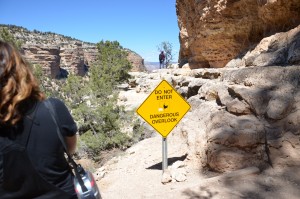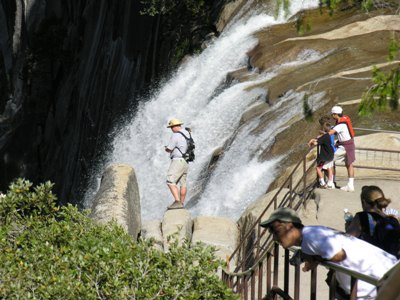
Safety concerns keep park rangers busy
An avoidable tragic accident involving an animal in 1977 left 5-year-old Colin Robert Neu dead. He was feeding a buck potato chips when the deer spooked and caught the boy by the arm, nicking an artery.
His accidental death was one of a number of unfortunate incidents that occur in national parks each year. But it is possible that such tragedies can be avoided with a bit of preparation. Reading about safety tips helps ensure a positive park experience and allows visitors to see the beauty from the America’s most precious resources.
 |
A bear rummages through a camper’s food storage locker (Photo courtesy of the National Park Service). |
Some parks are known for their wildlife while others pride themselves on their scenic natural splendor.
All parks, however, come with certain precautions that should be taken in order to ensure each visitor’s safety for an overall rewarding experience.
“As of right now, there is a nationwide effort to identify hazards within the National Park,” Roger Farmer, safety officer for Yosemite National Park in Northern California, said. “We address various issues, such as motor vehicle accidents, and try and correct the problem as soon as possible.
“At Yosemite, issues are brought to light by a feedback program through the Web site or through forms at the park.”
| Visitors along Bright Angel Trail in Grand Canyon National Park ignore a safety sign for a photograph (Staff photo). |  |
In many parks, huge strides are being made to provide public education for all visitors about a variety of hazards that in many cases can be avoided.
“The ability to communicate is a top priority because it allows for a shorter response time to a problem,” Jay Grass, safety officer for Glacier National Park, said. “At Glacier, we have resource protection rangers to protect the park and visitors.”
However, the National Park cannot be responsible for every person’s safety. Visitors should come prepared and know the facts and details about the park they are visiting. Whether they go hiking, camping or swimming, they need to be aware of their safety at all times.
Many safety tips can be found on the National Park Service Web site at http://www.nature.nps.gov/hazardssafety/index.cfm. Reading these tips is highly stressed for all visitors.
“A large degree is personal responsibility because, with limited staff, there is no way we can escort two million people through the park. However, we do as much as we can to provide emergency procedure,” said Grass.
Farmer also agreed that the responsibility is more up to the visitors.
“We can say things, but we can’t be everywhere at all times, so the public should try and educate themselves and recognize hazardous areas that might attract children and even themselves,” said Farmer.
| An ice storm took down trees across this Shenandoah National Park road (Photo courtesy of the National Park Service). |  |
At Shenandoah National Park, Lyme disease from ticks, Rocky Mountain spotted fever and slips, trips and falls are always a major concern.
“Visitors can do a lot to prepare themselves,” Charles Newton, safety engineer at Shenandoah National Park, said. “Avoid wearing slippery shoes, be aware of the differences of temperatures and bring rain gear if needed.
Some of the differences that set each park apart are the variety of different safety precautions of which visitors should be aware.
Poisonous vegetation and hungry alligators in the Everglades National Park are always major safety issues while the high population of black bears at Shenandoah National Park is a bigger concern for rangers there.
At Glacier National Park, for example, large predator animals such as mountain lions and grizzly bears present many safety issues that other parks do not have to deal with.
“National parks try to manage the activity of humans while not interfering with the animals,” said Farmer. “There is constant education of teaching the public to not affect the wildlife. Our goal is to preserve the park the way it was originally found and not encroach on the resources.”
When a river was running high and fast two years ago in the middle of a campground at Yosemite, even though the river was closed, people still disregarded the warnings and went into the water.
Trees that fell in the river were not taken out because it is park policy to allow nature to run its course, but it proved to be a serious hazard to people who tried to raft down the river when they weren’t supposed to. After four rescues in one weekend, the park made a change and heavily patrolled those areas to make sure no one went in the river.
“Even with all these safety precautions, there are still a number of injuries and even fatalities that occur in some of the national parks,” Farmer stated..”For example, Yosemite, on average has around 3,800 clinical visits, most dealing with minor injuries, 300 search and rescues and 10 to 15 fatalities each year.
“Compared to the number of visitors at Yosemite (three million plus visitors each year) and the natural setting and hazards, those numbers are low. However, it is against our profession to have anyone get hurt or die.”
A number of injuries in the national parks are a result of motor vehicle accidents. Whether it be windy roads, inadequate guard rails or other factors, visitors need to realize that driving within the park is not the same as driving on the highway.
“Many of the accidents reported are people who need help being carried out and most of them include motor vehicle accidents,” said Newton. “We haven’t had a fatality in a few years and we hope to continue that.”
There has not been much data provided by the National Park Service about fatality and injury statistics because of the vast amount of land and large number of visitors that come to the parks each year.
“Parks do respond to safety very effectively, but we do not have a very good system for incident reporting. However, we are working on it,” Richard Powell, chief of the Division of Risk Management for the National Park Service, said.
 |
A visitor ignores guardrail rules and takes a dangerous look at a waterfall at Yosemite National Park (Photo courtesy of Roger Farmer, Safety and Occupational Health manager at Yosemite National Park). |
If there is an accident or injury, visitors are urged to call 911 or the park dispatch number provided by the various parks if they have a working cell phone. If not, visitors have to be prepared for the weather conditions because having no communication can prove costly.
“It is very important for visitors to follow their itinerary. If they have a back-country permit and they’re not back when they said they were supposed to be, we can start looking for them. If they stayed on the trail, the easier it will be to find those people who are lost or in need of help,” said Farmer.
Many departments work together within the National Park Service to ensure a safe and positive experience for their visitors. Those visitors that want to be one with nature and do not extend themselves understand the importance of safety while others that are more care-free put themselves at greater risk.
“It’s the untamed wilderness that people come for. It’s an environment unlike any other,” said Farmer. We enjoy what we do and we try to provide a safe and enjoyable visitor experience.”
YOSEMITE PARK SEARCH AND RESCUE REPORT 2002
|
Type |
Incidents |
Injured / Ill |
Non-Injured / Ill |
Fatalities |
|
Hiking |
119 |
87 |
44 |
1 |
|
Skiing |
3 |
1 |
2 |
0 |
|
Boating |
1 |
0 |
3 |
0 |
|
Swimming |
0 |
0 |
0 |
0 |
|
Scuba |
0 |
0 |
0 |
0 |
|
Vehicle |
4 |
4 |
0 |
0 |
|
Climbing |
34 |
20 |
20 |
3 |
|
Bike |
1 |
0 |
1 |
0 |
|
Aircraft |
0 |
0 |
0 |
0 |
|
Stock |
0 |
0 |
0 |
0 |
|
Mutual Aid |
1 |
0 |
0 |
0 |
|
Unfounded |
7 |
0 |
1 |
0 |
|
Other |
12 |
4 |
2 |
0 |
|
Total |
182 |
116 |
73 |
4 |
Source: National Park Service.

Comments are Closed